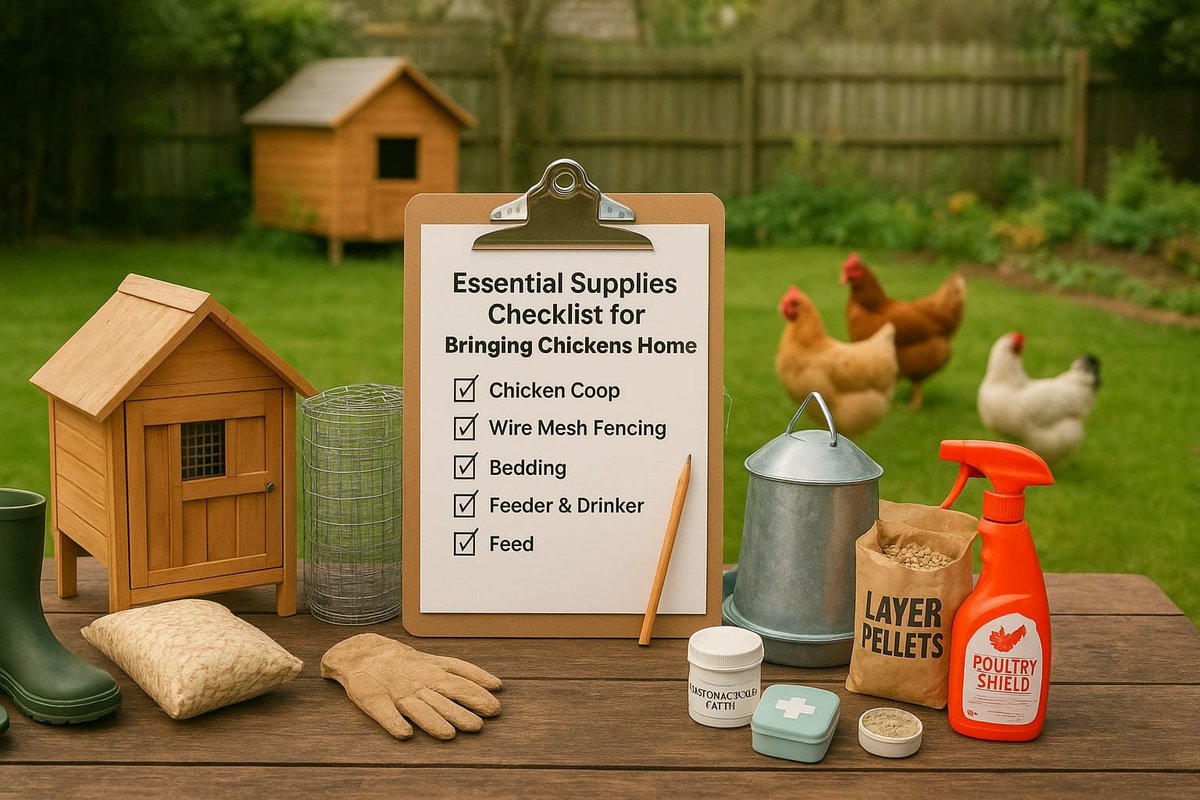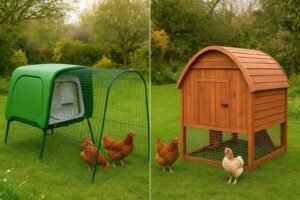So, you’re getting chickens! It’s one of the most exciting steps you can take towards a more sustainable life (and a supply of delicious, fresh eggs). But before you start choosing the best chicken breeds for small UK gardens, it’s easy to feel overwhelmed by the shopping list. What do you actually need to buy before they arrive? And what’s just a “nice to have”?
This guide is your complete, in-depth checklist. It covers everything you need to have set up and ready before your new hens set foot in your garden. It’s an essential companion to our complete UK chicken keeping overview. We’ll go beyond just what to buy and explain why each item is critical. We’ll cover housing, feeding, health, and the crucial legal bits you can’t ignore. This guide is fully updated for the 2025 UK regulations, including the mandatory registration for all keepers.
As a backyard chicken keeper in the UK myself, I’ve made all the classic mistakes so you don’t have to. This essential supplies checklist for bringing chickens home in the UK will make sure you, and your new flock, are ready for a smooth and happy start.
What You’ll Need: A Quick Overview
- Legal Requirements (FREE): You must register with APHA, even for one bird. You also need to check local rules.
- Housing: A predator-proof coop and a secure run are your biggest and most important investments.
- Daily Care: A quality feeder, drinker, and the correct, age-appropriate feed.
- Health & Safety: A basic first-aid kit, biosecurity supplies, and a robust prevention plan for red mites.
- Estimated Startup Cost: Be prepared for an initial cost of £300 to £1,200+, depending on your choice of coop and whether you buy new or second-hand. (See our complete cost breakdown for keeping chickens for a detailed budget).
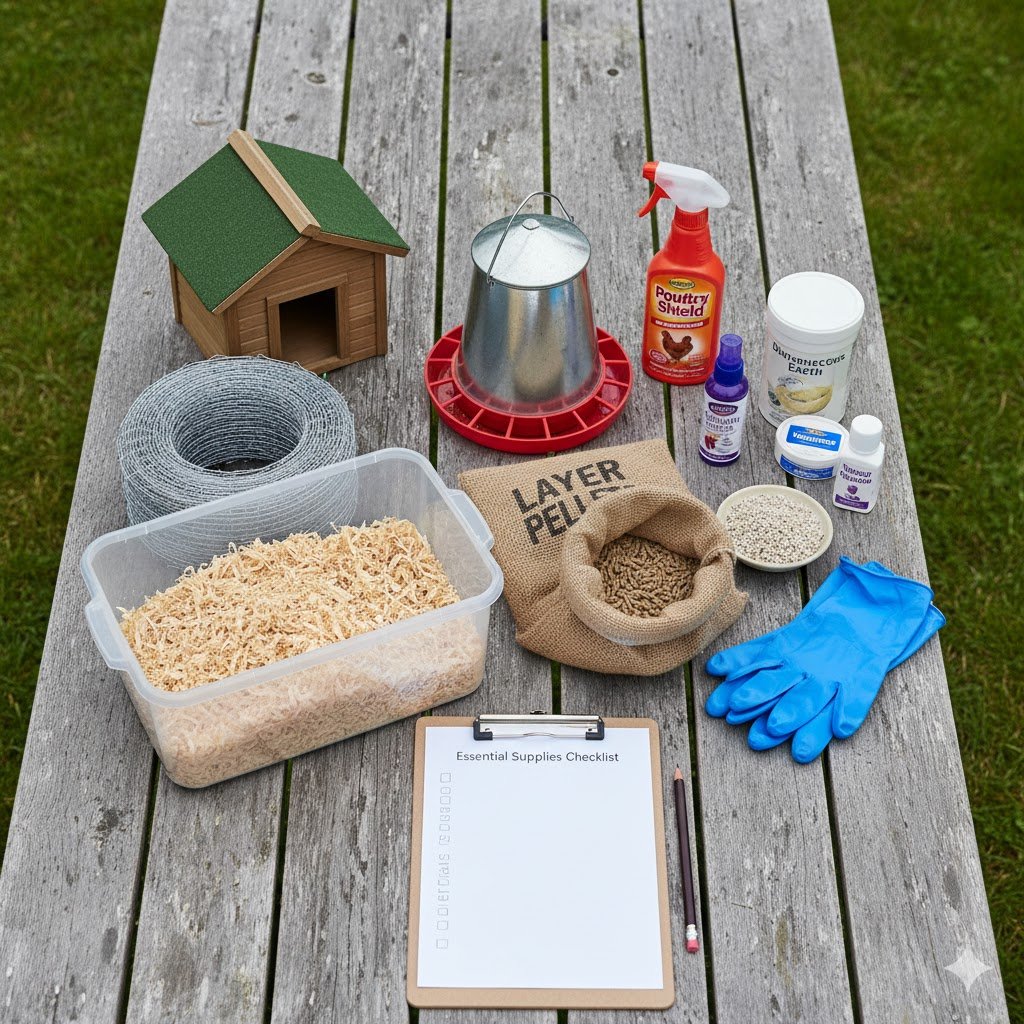
Before You Shop: Legal Requirements First (What Do I Need to Have Chickens in the UK?)
Before you buy a single item, your first job is to check the rules. This isn’t the fun part, but it’s the most important. Before buying any supplies, you must ensure you can legally keep chickens in your location and understand your registration obligations.
Registration with APHA (Mandatory and FREE)
This is the most important first step.
- What it is: You must register your chickens on the Great Britain Poultry Register (GBPR), which is run by the Animal and Plant Health Agency (APHA).
- Is it for me? Yes. Since the October 1, 2024 regulatory change, it is a legal requirement for all poultry keepers in Great Britain to register, even if you only have one bird. This used to be only for flocks of 50 or more, but the rules have changed to improve biosecurity.
- Cost: It is completely FREE.
- Why? It’s vital for national biosecurity. If there’s an outbreak of a notifiable disease like Avian Influenza (Bird Flu), APHA can contact you with critical information, alerts, and legal requirements (like having to keep your birds indoors) to protect your flock and stop the spread.
- Penalty: Not registering can lead to a fine of up to £2,500.
- How: You can do it online at the GOV.UK website. It only takes a few minutes. You’ll need your location details (a CPH number if you have one, but your address is fine for most) and the number/type of birds.
Check Your Property Documents
Don’t get caught out. Before you spend £500 on a coop, spend 20 minutes reading these documents for any rules, or “covenants,” that ban “livestock” or “poultry”:
- Local Council Bylaws: Most councils are fine with hens, but some may have rules on the number of birds or coop placement.
- Property Deeds or Covenants: Some housing estates (especially new builds) have surprisingly strict rules.
- Tenancy Agreements: If you rent, you must get written permission from your landlord.
- Allotment Rules: If you plan to keep them on an allotment, check the association rules. Many now ban poultry.
Are Cockerels Allowed? (And Cockerel Noise)
In 99% of urban and suburban settings, the answer is no, or at least “it’s a very bad idea.”
- Legality: While not always illegal to own, a cockerel’s crowing can be classed as a “statutory nuisance” under the Environmental Protection Act 1990. This means your council can legally serve you a notice to remove them.
- Reality: A cockerel doesn’t just crow at dawn. He crows all day. It’s incredibly loud and will destroy your relationship with your neighbours.
- Do I need one for eggs? No. Hens will lay eggs perfectly happily without a cockerel. You only need a cockerel if you want to hatch fertile eggs to get chicks.
Inform Your Neighbours
This is just good manners and can save a lot of trouble. A quick chat over the fence to let them know your plans is a great idea.
- Reassure them: “We’re getting 3-4 hens, and definitely no noisy cockerel!”
- Be clear on placement: Let them know the coop won’t be right against their fence (which helps prevent rat issues).
- Build goodwill: A few free eggs once they start laying is the best peace-offering you can give!
With the paperwork and neighbourly chats sorted, it’s time for the most exciting (and often most expensive) part: building their new home. Getting this right from day one is the single best thing you can do for your hens’ safety and health.
Essential Housing Supplies (What Your Chickens Need Before Arrival)
Your chickens need a secure, weatherproof home ready before they arrive. Do not buy your chickens and then build the coop. This is their safe space, and it needs to be 100% predator-proof from the moment they land.
The Chicken Coop (Your Biggest Investment)
Checklist Item 1: Secure Chicken Coop
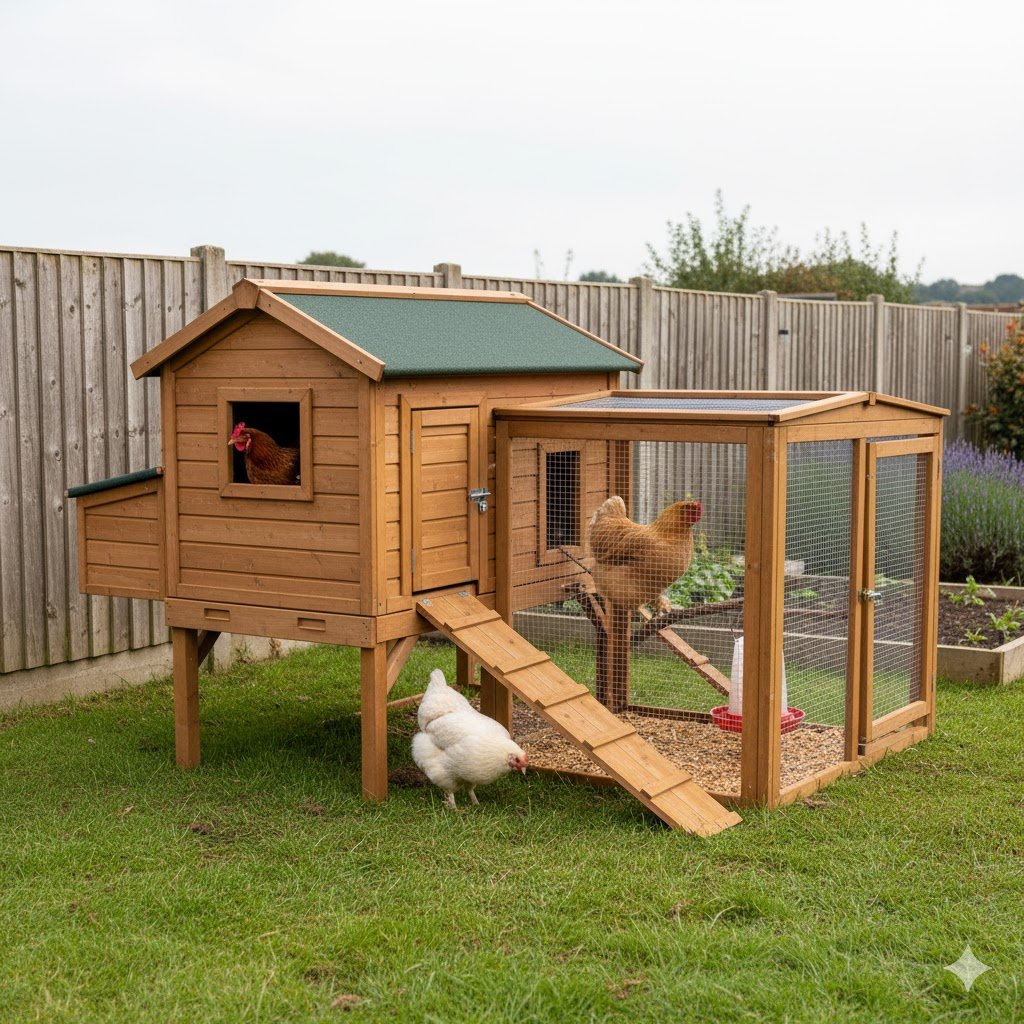
- What it is: A weatherproof and predator-proof house where your chickens will sleep, shelter, and lay their eggs.
- Space: You need a minimum of 2-4 sq ft per bird inside the coop. This is floor space. More is always better. Overcrowding leads to stress, pecking, and disease.
- Essential Features:
- Roosting Bars/Perches: Round or square-edged timber, at least 2 inches wide. Chickens sleep on these, not on the floor. They MUST be positioned higher than the nest boxes, or they’ll sleep (and poo) in the nest boxes.
- Nest Boxes: A dark, quiet, and private place to lay. You need at least one nest box for every 3-4 hens. They will all share their favourite one anyway, but you must provide the option.
- Pop Hole Door: A small door for them to get in and out, with a very secure lock (a simple twist-latch is not fox-proof). Use a bolt you can padlock.
- Ventilation: This is vital in the damp UK climate. Good ventilation (vents near the roof, away from the perches) lets ammonia and moisture escape without creating a cold draught. Poor ventilation causes respiratory diseases.
- Droppings Tray: A removable tray under the perches makes the “poo-picking” part of your daily clean so much easier.
- Cost: £150 for a basic flat-pack up to £1,000+ for a premium, walk-in coop.
- Fox Protection: Foxes are strong and clever. They can lift unsecured lids, pull open simple latches, and tear through thin wood. Locks must be strong bolts, not just twist-catches. We review several fox-proof coop options for UK keepers in our dedicated guide.
- Personal Tip: I started with a £200 flat-pack coop. I regretted it within six months. The wood warped in the damp, the roof felt leaked, and its dozens of tiny cracks became a paradise for red mites. The £450 coop with thicker, treated timber I bought to replace it has saved me money and stress in the long run.
Choosing Your Coop: Wood vs. Plastic
This is a major debate for new keepers.
- Wooden Coops:
- Pros: Traditional look, cheaper initial cost, good insulation, easily customisable (you can add locks or perches).
- Cons: Harder to clean. Prone to warping and rot in UK damp. They are a perfect habitat for red mites, which hide in the thousands of cracks and joints.
- Plastic Coops (e.g., Omlet, Nestera):
- Pros: Extremely easy to clean (often just need a hose or pressure wash). No cracks for red mites to hide in, making mite control 99% easier. Very durable and weatherproof.
- Cons: Much higher initial cost. Can get very hot in direct summer sun (must be in shade). Less “traditional” looking.
My Verdict: If you can afford it, a good quality plastic coop will save you hundreds of hours of cleaning and stress over red mites. If you go for wood, buy the best quality you can afford and be relentless with your red mite prevention plan from day one.
Where to Position Your Coop in a UK Garden
Where you put the coop is just as important as the coop itself.
- Shelter: Don’t put it in the most exposed, windy corner of your garden. Tuck it against a fence, wall, or hedge to give it protection from the worst of the wind and rain.
- Shade: It must have shade, especially in the afternoon. Chickens can overheat and die in hot weather. Placing it under a tree or in the shade of a shed is ideal. If it’s in an open spot, you’ll need to put up a sunshade (tarp) in summer.
- Drainage: Don’t put it at the bottom of a slope or in the boggiest part of your garden. The run will turn into a nightmarish mud pit in winter. Build it on the highest, driest ground you can. Keeping your coop dry in UK weather is a major challenge, and good positioning is the first step.
- Convenience: You have to visit it at least twice a day, every day, in all weather. Don’t put it so far away that it’s a chore to get to in the pouring rain or snow.
Secure Chicken Run or Fencing
Checklist Item 2: Secure Chicken Run or Fencing
- What it is: An enclosed outdoor space where your chickens can forage, dust-bathe, and be safe from predators.
- Space: The UK welfare standard is a minimum of 8-10 sq ft per bird. This is a minimum. More space is always better and will mean a cleaner run and happier, healthier birds.
- Fencing Type: You must use welded wire mesh (also called hardware cloth), not standard chicken wire. A fox can tear through thin chicken wire in seconds. This is probably the most common (and tragic) mistake new keepers make. Use 19-gauge or thicker.
- Predator Protection (Beyond Foxes):
- Badgers & Diggers: Dig the wire mesh 6-12 inches underground and then outwards in an “L” shape (a “skirt”). This stops predators from digging under.
- Rats: Rats are attracted to spilt feed, not the chickens. A 1/2-inch mesh will keep out adult rats, but you also need to manage your feed (see H2: Daily Care Supplies).
- Stoats & Weasels: These can get through tiny gaps. Your mesh must be securely fixed with no gaps, and the coop itself must be solid.
- Birds of Prey: A roof on the run (mesh or solid) is the only way to protect them from large hawks or buzzards, especially in rural areas.
- Alternative: Electric poultry netting (£80-£150) is a great, flexible option if you want to move their run around the garden. It’s very effective against foxes.
Bedding Material for Coop
Checklist Item 3: Bedding Material for Coop
- Initial Supply Needed: One large bale or bag. (See our detailed guide to bedding options for UK’s damp climate for a full comparison.)
- Options:
- Options:
- Wood Shavings (Dust-Extracted): My top recommendation for the UK. It’s very absorbent and low-dust, which is vital for preventing respiratory issues in our damp climate. Costs £10-£15 per large bale. Ensure it says “dust-extracted.”
- Hemp Bedding: Also excellent. Highly absorbent, composts well, and great for wet conditions. A bit more expensive at £12-£18.
- Straw: A budget option (£8-£12), but it holds moisture and can get mouldy and smelly very fast. It’s also not very absorbent for droppings. It’s fine for nest boxes, but I avoid it for the main coop floor.
- For Nest Boxes: I use a thin layer of shavings in the bottom of the nest box (to absorb any broken eggs) and top it with soft straw. Chickens seem to prefer this for laying. Never use hay, as it goes mouldy quickly.
- UK Tip: Trust me, in our damp climate, paying a few extra pounds for dust-extracted shavings or hemp is worth every penny to protect your hens’ sensitive respiratory systems.
A secure, well-placed, and dry home is the foundation. Now you need to furnish it with the daily essentials: food and water. Getting the right equipment here will save you money, time, and keep your flock healthy.
Daily Care Supplies (Feeding & Watering Essentials)
These supplies ensure your chickens have constant access to food and clean water, which is both a legal requirement under the Animal Welfare Act and a basic necessity. This section is also your front line in the war against rodents.
Feeding Equipment
Checklist Item 4: Chicken Feeder
- What you need: A sturdy hopper or gravity feeder that keeps the food clean and dry.
- Capacity: Get one that holds at least 3kg of feed for 4 hens. This will last them 2-3 days.
- Why quality matters: Cheap, thin plastic feeders will be knocked over, spilling and wasting expensive feed. They also crack in the first frost.
- Best type for UK:
- Hanging Feeder: My preferred option. Hanging it so the lip is level with the birds’ backs stops them from scratching bedding (and poo) into it.
- Treadle Feeder: This is a rat-proof metal feeder that only opens when a chicken stands on the step. They are a brilliant investment (£50-£80) if you know you have a rat problem.
- Cost: £15-£40 for a good plastic or galvanised feeder, or £50-£80 for a treadle style.
- Personal Experience: My first £8 feeder cracked after one winter frost and wasted so much feed by being knocked over. The £25 galvanised steel hanging one I bought to replace it is still going strong three years later.
Checklist Item 5: Layer Pellets or Mash
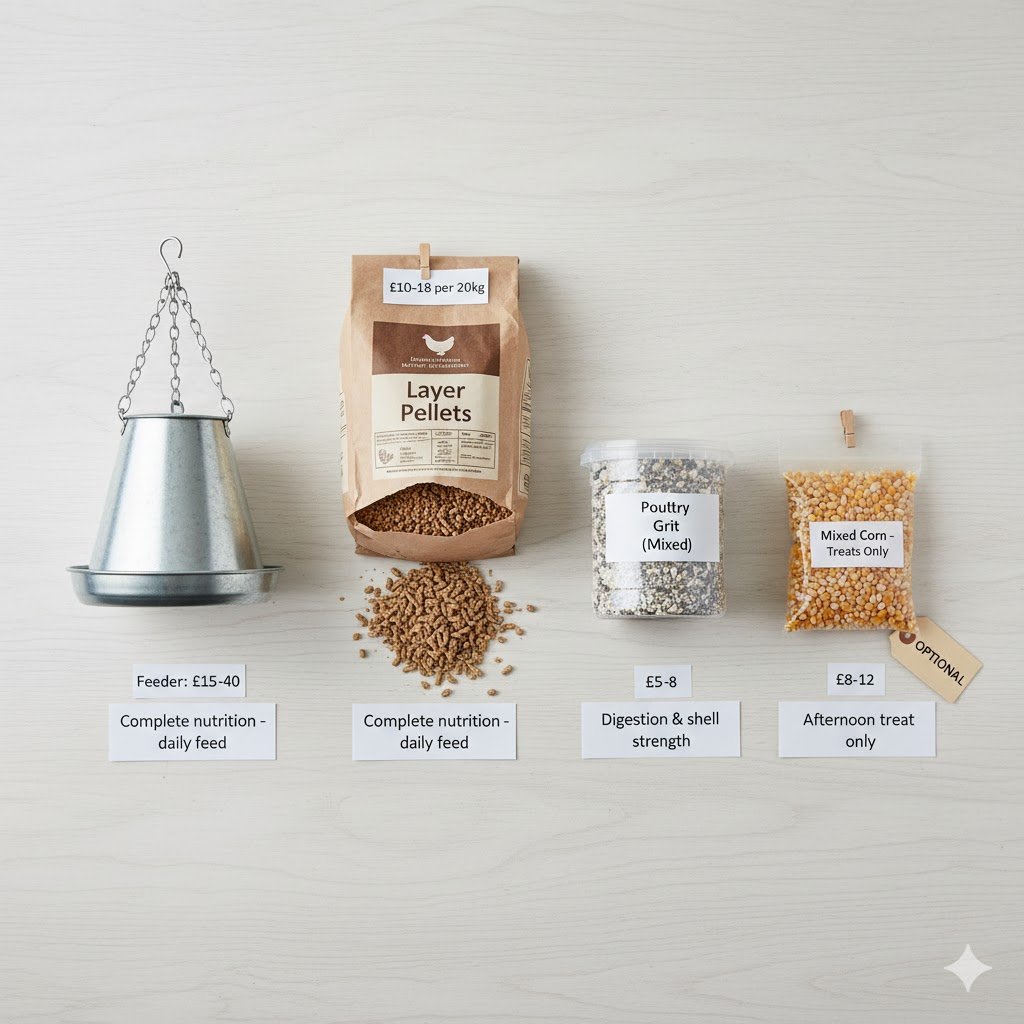
- What to buy: A formulated “layers” feed. This is their complete nutrition and has all the protein (16-18%) and calcium they need to lay eggs.
- Amount: A 20kg bag costs around £10-£18 and will last 4-5 weeks for 4 hens (each bird eats about 120-150g per day).
- Pellets vs. Mash: Pellets create less waste as the birds can’t just pick out their favourite bits. Young hens (Point of Lay) are often started on mash, so it’s good to check. (Check our guide to recommended UK poultry feed brands if you’re not sure what to buy.)
- First Bag Tip: Find out exactly what brand and type of feed your hens are currently eating. Buy one 20kg bag of the same stuff. A sudden food change can cause stress and upset stomachs. If you want to change brands, do it gradually by mixing the two feeds over a week.
Understanding Chicken Feed: Starter, Grower vs. Layer
You may see other bags of feed. It’s critical you buy the right one.
- Chick Crumb (Starter): For 0-5 weeks. Very high protein (20-24%).
- Grower Pellets: For 6-18 weeks. Lower protein (18-20%).
- Layer Pellets/Mash: For 18+ weeks (when they start laying). Lower protein (16-18%) but very high in calcium. CRITICAL: Do NOT feed “Layer” feed to young chicks (it can damage their kidneys) and do NOT feed “Grower” feed to laying hens (they won’t get enough calcium, leading to soft-shelled eggs and health problems like egg-binding).
How to Store Feed to Prevent Rodents and Spoilage
- Problem: Your 20kg bag of feed is a giant “OPEN” sign for rats and mice.
- Solution: You MUST store your feed in a galvanised steel dustbin with a tight-fitting lid. Plastic bins are not enough; rats will chew right through them. This is just one part of keeping rats away from your chicken setup.
- Where: Store this metal bin in a dry shed or garage, not in the open. Damp feed goes mouldy, and mouldy feed can kill chickens.
Checklist Item 6: Mixed Corn (Optional Treat)
- What it is: A mix of wheat and cracked maize.
- Usage: This is a treat, not a main food. It’s like sweets for chickens. Give them a small handful per bird in the afternoon, max.
- Purpose: It’s high in energy (carbs) and helps them stay warm at night, especially in winter. It’s also great for taming your birds (“corn-taming”) and for encouraging them back into the coop at night.
- Warning: It is not nutritionally complete. It should be no more than 10% of their total diet.
Checklist Item 7: Poultry Grit
- What it is: A mix of two things: insoluble flint grit (tiny stones) and soluble oyster shell (crushed shells). Read our guide on why chickens need grit and oyster shell for a full explanation.
- Why essential:
- Digestion: Chickens have no teeth. They need the insoluble flint grit to grind up their food in their gizzard.
- Eggshells: They need the soluble oyster shell to provide a massive boost of extra calcium to form strong eggshells.
- How to provide: In a small, separate hanging cup or dish. Don’t mix it with their main feed; they will self-regulate and take what they need.
- Cost: A 1.5kg bag costs £5-£8 and lasts for months.
Watering Equipment
Checklist Item 8: Water Drinker/Waterer
- Capacity: A 5-8 litre plastic drinker is a good size for 4 hens. You need at least 1 litre per bird, plus a spare litre.
- Type: A hanging or standing plastic drinker is fine.
- Cost: £10-£25.
- Winter Consideration: Water freezes in the UK winter. This is a serious problem. You will need to swap the water out at least twice a day, or you can buy a heated base (£15-£30) to sit the drinker on.
- Placement & Hygiene: This is critical. Hang the drinker or place it on a couple of bricks. This stops the birds from kicking bedding and dirt into their fresh water. Water contaminated with droppings is a primary cause of disease, especially Coccidiosis. You must be able to clean it easily.
With the house, food, and water sorted, you’re almost ready. The final area of preparation is health and hygiene. Having these supplies on hand before you need them is the difference between a minor issue and a full-blown emergency.
Health & Hygiene Supplies (Essential From Day One)
Prevention is always better (and cheaper!) than cure. These supplies help you maintain a healthy flock, prevent the dreaded red mite, and be ready to handle minor injuries.
First Aid & Health Kit
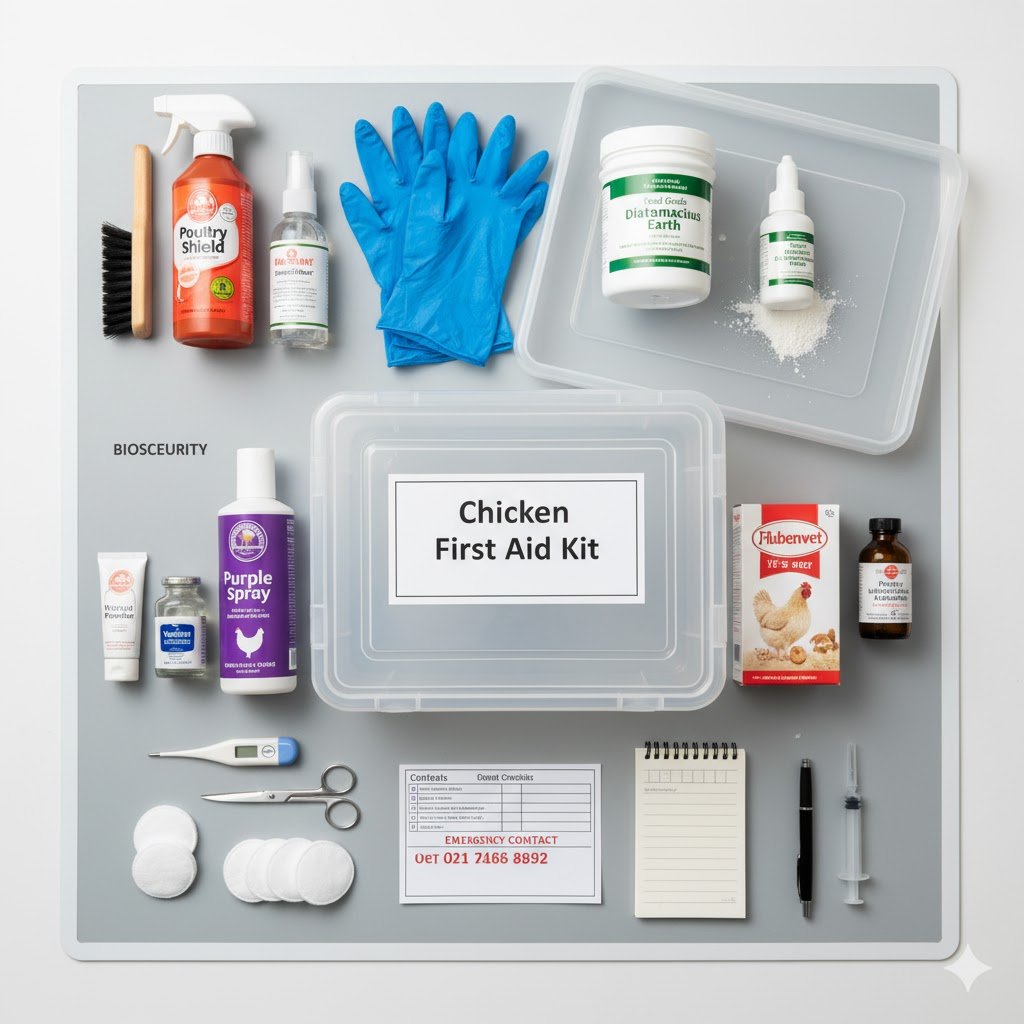
Checklist Item 9: Poultry Shield or Coop Disinfectant
- What it is: A non-toxic disinfectant and detergent specifically for poultry housing.
- When to use: You’ll use this for your big pre-arrival deep clean and then for your regular weekly or monthly clean-outs.
- Cost: £12-£15 for a 1-litre bottle of concentrate.
- Why critical in UK: It is excellent at breaking down the waxy coating and biofilms of red mites. Red mites are the number one nightmare for UK chicken keepers, especially in wooden coops. They hide in cracks and suck the birds’ blood at night, causing anaemia and death. Start your prevention plan from day one. For more, see our comprehensive red mite prevention and treatment guide.
Checklist Item 10: Diatomaceous Earth (DE) or Diatom Powder
- What it is: A natural, fine powder made from fossilised algae. Under a microscope, it’s sharp and kills parasites like mites and lice by drying them out. (Read our complete guide to using diatomaceous earth for detailed application instructions.)
- Uses: Puff it into all the cracks, crevices, and perch-ends in the coop after cleaning. Add a good handful to their dust bath.
- Cost: £8-£12 for a small puffer bottle, or £20-£30 for a large 2kg bag.
- Application: Use it weekly as a preventative, especially during the warm summer months (red mite season). Always wear a dust mask when applying it.
Checklist Item 11: Basic First Aid Supplies Your “chicken first aid kit” should be a waterproof, labelled box containing: We also have a detailed chicken first aid kit setup guide you can follow.
- Antiseptic Spray: Purple Spray (£8-£12) is the classic. It disinfects and hides the red colour of any wound, which prevents other chickens from pecking at it.
- Wound Powder: £6-£10. A styptic powder that helps to stop minor bleeding quickly (e.g., from a broken claw).
- Vaseline: £3-£5. The best and cheapest treatment for scaly leg mite (slather it on their legs to suffocate the mites).
- Worming Treatment: (e.g., Flubenvet) £20-£30. This is the only licensed in-feed wormer. You should plan to worm your flock 1-2 times a year.
- Extra Supplies: A pair of gloves, some sterile saline solution (for cleaning wounds), and some poultry-specific vitamins/electrolytes to add to water during times of stress.
- Storage: Keep all this in a waterproof, clearly-labelled container near the coop.
Checklist Item 12: Dust Bath Setup
- Container: A large cat litter tray, an old tyre laid flat, or a shallow wooden tray.
- Material: A mix of dry soil, sand, and a good handful of Diatomaceous Earth.
- Purpose: This is how chickens “bathe.” It’s essential for their feather health and for controlling parasites naturally. Read our dust bath setup guide for mite prevention for more details.
- Location: It must be in a covered area, like in their run under a small roof, so it stays dry in the UK rain. A wet dust bath is useless and will just become a muddy mess.
How to Find a Poultry Vet (Before You Need One)
This is a step almost every new keeper forgets. Most vets are “small animal” (cat/dog) vets and will not treat chickens.
- Action: Before your chickens arrive, phone all the local vet practices in your area and ask them one simple question: “Do you have a vet on staff who treats backyard poultry?”
- Why: You do not want to be desperately Googling “chicken vet near me” at 8 PM on a Friday when you have a sick or injured bird.
- Cost: Be aware that vet treatment for chickens can be expensive. A simple consultation can be £50-£80. You need to be prepared for this as part of your duty of care.
Daily, Weekly, and Monthly Health Checks
You are the first line of defence.
- Daily Check (30 seconds): When you feed them, watch them. Are they all active? Rushing for food? Any standing apart, hunched, or looking “fluffed up”?
- Weekly Check (5 minutes): Pick a day to do a quick visual check. Look for any coughing or sneezing. Check their droppings for any signs of blood or worms.
- Monthly Check (5 minutes per bird): This is your full “MOT.” Pick each bird up. Check her weight (does she feel lighter?), check her eyes (bright and clear?), check her bottom (clean?), and check under her wings and around her vent for any signs of lice or mites.
You’ve got the legal a-ok, the house is built, the pantry is stocked, and the first aid kit is ready. Now for the exciting part: the “gotcha day”! Here’s what you need for a smooth and stress-free arrival day.
Arrival Day Essentials (What to Do When Bringing Chickens Home)
The first 24 hours are crucial for helping your chickens settle into their new home with minimal stress. What supplies do I need for backyard chickens on day one? These.
Transport & First Hours Supplies
Checklist Item 13: Secure Transport Box/Carrier
- What you need: A ventilated pet carrier (a cat carrier is perfect) or a sturdy cardboard box with plenty of air holes punched in it.
- Capacity: Don’t crowd them. One carrier per 2-3 birds, max.
- Bedding: Put some newspaper or shavings in the bottom.
- Travel Tip: I always collect new hens in the late afternoon. This gives them a short time to explore the coop and then go to roost for the night, which helps them settle before facing a full, scary day. Travel them in the car boot (if ventilated) or securely in a footwell, and drive gently.
Quarantine: A Critical Step for Biosecurity
If you are adding new chickens to an existing flock, you MUST quarantine the new birds for a minimum of 2-3 weeks.
- What it means: Keep them in a completely separate coop and run, far away from your old flock.
- Why? They could be carrying diseases or parasites (like mites) that they aren’t showing symptoms of yet. Adding them immediately could wipe out your entire flock.
- For First-Time Keepers: If all your hens are arriving on the same day from the same place, you don’t need a separate quarantine pen. Your entire setup is their “quarantine” from the outside world.
Checklist Item 14: Arrival Day Setup (The 24-Hour Lockdown)
- Before they arrive: Place their feeder and drinker inside the coop.
- Bedding ready: A fresh, deep layer of bedding in the coop and nest boxes.
- Pop Hole Closed: This is the most important step. When you arrive, put the chickens inside the coop and lock the pop hole. Keep them inside the coop for the first 24 hours.
- Why? This teaches them that “this is home” and this is where they are safe. It ensures they learn to return to the coop to roost at night. If you let them out straight away, they may get confused and try to roost in a tree or under a bush.
First Week Management
Checklist Item 15: Settling Period Supplies
- Electrolytes/Tonic (Optional): £8-£12. You can add a poultry tonic to their water for the first few days to help with the stress of the move.
- Extra Treats: A small amount of mixed corn is great for hand-taming and building trust.
- Your Time: Plan to be home at dusk for the first few evenings. You may need to gently herd them back into the coop until they learn the routine. Don’t worry, they learn fast!
- Patience: The morning after arrival, open the pop hole and let them come out and explore their new run in their own time. Don’t force them out. It might take them hours, and that’s perfectly normal.
- What to expect: They will be quiet and shy for the first few days. This is normal settling-in behaviour.
Once your hens are settled, you’ll fall into a regular routine. A huge part of that routine is cleaning. Having the right tools and a smart system makes this a quick job rather than a dreaded chore.
Cleaning & Maintenance Supplies
Regular cleaning prevents disease, pests, and smells. A clean coop is a healthy coop.
Checklist Item 16: Cleaning Tools
- Dedicated Shovel/Scoop: £10-£15. A square-mouthed shovel is great for scraping out bedding.
- Stiff Brush: £8-£12. For scrubbing perches and walls.
- Scraper: A simple, long-handled paint scraper is the best tool for getting caked-on droppings off perches and trays.
- Bucket: £5-£8. For mixing disinfectant.
- Rubber Gloves: £3-£5.
- Dust Mask: £8-£12. Essential. Changing dusty bedding can be bad for your lungs.
- Wheelbarrow: Very useful for a “deep clean” to transport old bedding to the compost heap.
Checklist Item 17: Ongoing Bedding Supply
- Monthly Need: You’ll get through 1-2 large bales of bedding per month for 4 birds, depending on your cleaning method.
- Storage: You must have somewhere dry (a shed or garage) to store your spare bedding and feed.
Choosing Your Cleaning Method: Deep Litter vs. Weekly Clean
- Weekly Clean-Out: This is what most beginners do. Once a week, you scrape out all the old bedding, sweep it out, and put fresh bedding in.
- Deep Litter Method: This is a more advanced “hot compost” method. You start with a 4-inch layer of bedding and just “turn” it every few days, adding a fresh thin layer on top. You only do a full clean-out once or twice a year.
- Pros: Less work, creates fantastic compost, and the biological activity can create warmth in winter.
- Cons: It requires careful management to stop it from getting wet or smelly, and it needs excellent ventilation.
How to Safely Compost Chicken Manure
Chicken manure is “black gold” for gardeners, but it’s very “hot” (high in nitrogen).
- Do NOT: Put fresh chicken manure straight onto your plants. It will burn them.
- Do: Add it to your compost heap, mixed with “brown” materials like cardboard, leaves, or paper. It will supercharge your compost. It needs to rot down for at least 6-9 months before it’s safe to use in the garden.
You now have everything for the essential running of your flock. The following items aren’t strictly necessary, but from my experience, they make the hobby significantly easier, safer, and more fun.
Optional But Highly Recommended Supplies
These items aren’t “day one” essentials, but I’d strongly consider budgeting for them, as they make chicken keeping significantly easier and more enjoyable.
Checklist Item 18: Egg Collection Basket
- Cost: £8-£15
- Purpose: A proper wire basket lets eggs cool, allows any dirt to fall off, and stops you from cracking them in your pockets (trust me, it happens).
Checklist Item 19: Automatic Coop Door
- Cost: £80-£150
- Benefit: This was the best £100 I ever spent on my chickens. It opens the coop at dawn and (most importantly) securely locks it at dusk, using either a timer or a light sensor. (See our recommended automatic coop doors for UK keepers if you’re ready to buy.)
- Worth it if: You work long hours, want a weekend lie-in, or you have “lock-up anxiety” about forgetting to lock them in before the foxes come out.
Checklist Item 20: Weather Protection
- Run Cover/Tarp: £15-£30. A clear tarpaulin sheet fixed over part (or all) of their run is a lifesaver.
- Purpose: It gives them a dry area to shelter from the heavy UK rain and stops the run from becoming a total mud pit in winter. (We have a full guide on solutions for muddy runs in British weather if this becomes a problem). This is also a legal requirement during an Avian Flu “flockdown.”
- Woodchip for Run Floor: £10-£20 per bag. Hardwood woodchip is excellent for run floors as it drains well and gives the birds something to scratch in.
Checklist Item 21: Chicken Treats & Enrichment
- Hanging Cabbage/Greens Holder: £8-£12.
- Pecking Blocks: £5-£10. A solid block of grains and seeds they can peck at.
- Purpose: Stops boredom. A bored chicken can become a naughty chicken (e.g., feather pecking). Giving them a cabbage to peck at provides hours of entertainment.
Boredom Busters: Why and What to Buy
A chicken’s natural behaviour is to forage and scratch all day. A small, boring run can lead to behavioural problems.
- Chicken Swing: Yes, it’s a real thing. Some hens love it.
- Perches in the Run: Simple branches or 2x4s placed in the run give them different heights to explore.
- A Pile of Leaves: Rake up autumn leaves and put them in their run. They will spend hours happily scratching through them.
Coop Monitoring
- Wireless Thermometer: A simple indoor/outdoor thermometer (£10-£15) with the sensor in the coop lets you know how hot or cold it’s getting, so you can ventilate or insulate accordingly.
- Coop Camera: A cheap Wi-Fi security camera (£25-£50) pointed at the coop is fantastic for peace of mind. You can check they’ve all gone to bed safely without going out in the rain.
Keeping chickens in the UK comes with specific responsibilities. We’ve touched on some, but this section summarises the critical laws you must follow after your hens have arrived.
UK-Specific Legal Compliance Checklist (Critical Info)
Beyond the one-time registration, these are the ongoing legal requirements you must follow as a chicken keeper in the UK. This is serious YMYL (Your Money or Your Life) territory.
Feeding Regulations (Critical to Understand)
This is the one law almost all new keepers get wrong. What’s ILLEGAL to Feed Your Chickens in the UK:
- ❌ ALL kitchen scraps.
- ❌ Yes, even from a vegan household.
- ❌ Any food that has entered your kitchen. This includes vegetable peelings, leftover pasta, rice, bread, or plate scrapings.
- ❌ Meat or meat products.
Why it’s banned: It is classed as “catering waste.” The ban is in place, as stated in official APHA guidance, to prevent the spread of animal diseases like Foot and Mouth. This can be passed on through cross-contamination in your kitchen, which is why, as explained by the British Hen Welfare Trust, the ban includes scraps from vegan households.
What’s LEGAL to Feed Your Chickens:
- ✓ Commercial poultry feed (pellets, mash).
- ✓ Whole grains (like mixed corn) that have not entered your kitchen.
- ✓ Fresh garden produce (greens, weeds, windfall apples) taken directly from the garden to the chickens. It must not go via your kitchen.
- ✓ Shop-bought vegetables that have been stored in a shed or garage (i.e., not in your kitchen).
Penalty: Fines and potential prosecution under animal by-products regulations.
Welfare Obligations (Animal Welfare Act 2006)
You are legally responsible for meeting the “Five Freedoms” for your animals, as required by the Animal Welfare Act 2006:
- Freedom from hunger and thirst (daily fresh food and water).
- Freedom from fear and distress (protection from predators, gentle handling).
These freedoms form the basis of all animal care in the UK, and following RSPCA welfare recommendations will ensure you are meeting these obligations.
Minimum Flock Size: Never, ever keep just one chicken. They are highly social flock animals and will be lonely, stressed, and miserable on their own. A minimum of 3-4 hens is the perfect number to start with.
Your Legal Duty of Care for Sick Birds
Under the Animal Welfare Act, you have a legal duty to provide care for a sick or injured animal.
- This means: You can’t just “let nature take its course” if a bird is clearly suffering.
- Your options:
- Take it to a vet for treatment.
- If treatment is not viable, you must arrange for it to be humanely culled (euthanised). A vet can do this.
Legal Requirements for Disposing of Deceased Hens
This is a grim, but necessary, thing to know.
- Do NOT: Just put a dead bird in your household waste bin (in most council areas).
- Legality: A dead hen is classed as “Animal By-Product” (ABP).
- Your Options:
- Burial: You can legally bury a small number of birds in your own garden, as long as it’s deep enough (at least 2 feet) to prevent predators from digging it up and it’s not near any watercourse.
- Veterinarian: Your vet can arrange for cremation (this will cost money).
- Local Fallen Stock Collector: You can pay for a licensed collector to take it.
That was a lot of information! Let’s pull all the “shopping” items together into one simple, printable list you can take with you to the agricultural store.
Complete Shopping Checklist (Printable Summary)
Use this categorized checklist when you go shopping. Tick items off as you purchase them.
| Category | Item | Essential or Optional | Est. Cost |
|---|---|---|---|
| Legal | APHA Registration | ESSENTIAL | FREE |
| Housing | Chicken Coop | ESSENTIAL | £150 – £1,000+ |
| Secure Run/Fencing (Welded Mesh) | ESSENTIAL | £50 – £300 | |
| Bedding (Dust-Extracted Shavings) | ESSENTIAL | £10 – £15 | |
| Feeding | Feeder (Hanging) | ESSENTIAL | £15 – £40 |
| Feed Storage (Metal Bin) | ESSENTIAL | £20 – £30 | |
| Layer Pellets (20kg) | ESSENTIAL | £10 – £18 | |
| Poultry Grit | ESSENTIAL | £5 – £8 | |
| Mixed Corn | Optional | £8 – £12 | |
| Water | Drinker (5-8L) | ESSENTIAL | £10 – £25 |
| Heated Base | Optional | £15 – £30 | |
| Health | Poultry Shield | ESSENTIAL | £12 – £15 |
| Diatomaceous Earth | ESSENTIAL | £8 – £12 | |
| First Aid Kit (Purple Spray, etc.) | ESSENTIAL | £50 – £100 | |
| Dust Bath Setup (Tray/Sand) | ESSENTIAL | £10 – £15 | |
| Cleaning | Shovel/Scoop & Scraper | ESSENTIAL | £10 – £15 |
| Brush, Bucket & Gloves | ESSENTIAL | £15 – £20 | |
| Dust Mask | ESSENTIAL | £8 – £12 | |
| Arrival | Transport Carrier | ESSENTIAL | £15 – £30 |
| Optional | Egg Basket | Optional | £8 – £15 |
| Automatic Door | Optional | £80 – £150 | |
| Run Cover (Tarp) | Optional | £15 – £30 | |
| Pecking Blocks / Enrichment | Optional | £10 – £20 | |
| Coop Camera / Thermometer | Optional | £30 – £60 | |
| TOTAL (Essential) | £388 – £1,655 | ||
| TOTAL (With Optional) | £554 – £2,092 |
The total cost can be scary, but there are smart ways to save money without cutting corners on welfare.
Money-Saving Tips for First-Time Buyers
You can reduce startup costs without compromising your chickens’ welfare. Here’s how to be smart about your initial purchases.
- DIY Coop: If you’re handy, you can build a very sturdy coop from reclaimed pallets or timber for a fraction of the price (£50-£100 vs. £500+).
- Second-Hand Equipment: Check Facebook Marketplace or Gumtree. You can often find coops and runs for a deep discount. BUT you must deep clean and disinfect any second-hand coop thoroughly with a strong, dedicated disinfectant (like Virkon S, followed by Poultry Shield) to kill any red mites, parasite eggs, and diseases.
- Rescue Hens: Instead of buying Point of Lay hens (£18-£40 each), consider adopting rescue hens from a charity like the British Hen Welfare Trust. You’ll give ex-commercial hens a wonderful retirement, and they cost only a small donation (£2.50-£5 per bird).
- Bulk Buying: Feed and bedding are often cheaper in larger quantities or if you can “click and collect” from a local agricultural merchant rather than a high-street pet shop.
- DIY Enrichment: You don’t need to buy a “cabbage holder.” Just tie a string around the cabbage and hang it. An old tyre makes a perfect dust bath frame. A log or thick branch makes a great run perch.
Where NOT to Skimp:
- ❌ Coop Quality: A cheap, thin coop will need replacing in 2 years. I learned this the hard way. Buy the best you can afford.
- ❌ Predator Protection: A fox will find any weakness. Use welded mesh, not chicken wire.
- ❌ Quality Feeder: A good feeder prevents waste, which saves you a lot of money on feed.
- ❌ Feed Storage: A £25 metal bin saves you from a £300 rat infestation.
By being smart about your purchases, you can avoid the common pitfalls. Here are the mistakes I see new keepers make time and time again.
Common Mistakes to Avoid When Buying Supplies
Learn from my mistakes. Here are the top supply errors new UK chicken keepers make.
- Buying Chickens Before Supplies Your coop must be built, in position, cleaned, and ready with bedding, food, and water before your chickens arrive.
- Undersized Housing Many coops advertise “holds 6 hens” when they mean 6 tiny bantams. Calculate the actual square footage. Always buy a coop that’s bigger than you think you need.
- Forgetting Registration It’s free, it’s mandatory, and it’s the law. Set a calendar reminder.
- Using Standard Chicken Wire for Predators I will say it again: Foxes can tear through chicken wire like paper. You MUST use 19-gauge (or thicker) welded wire mesh. This is the most common and heartbreaking security failure.
- Not Planning for British Weather Our damp climate is tough on chickens. You need excellent coop ventilation (without draughts) and super-absorbent, dust-extracted bedding to prevent respiratory problems. A muddy run makes for unhappy hens.
- No Red Mite Prevention Plan Red mites are the UK’s #1 poultry parasite. They hide in cracks in wooden coops and suck the blood of your hens at night. You must have a prevention plan (Poultry Shield, DE powder) from day one.
- Not Locating a Vet in Advance Scrambling to find a vet during an emergency is incredibly stressful. Do it now, while things are calm.
- Not Buying a Metal Feed Bin You will get rats. I guarantee it. Buy the metal bin from day one.
You’re almost there! This final checklist will walk you through the final week of preparation.
Your Week-Before-Arrival Checklist
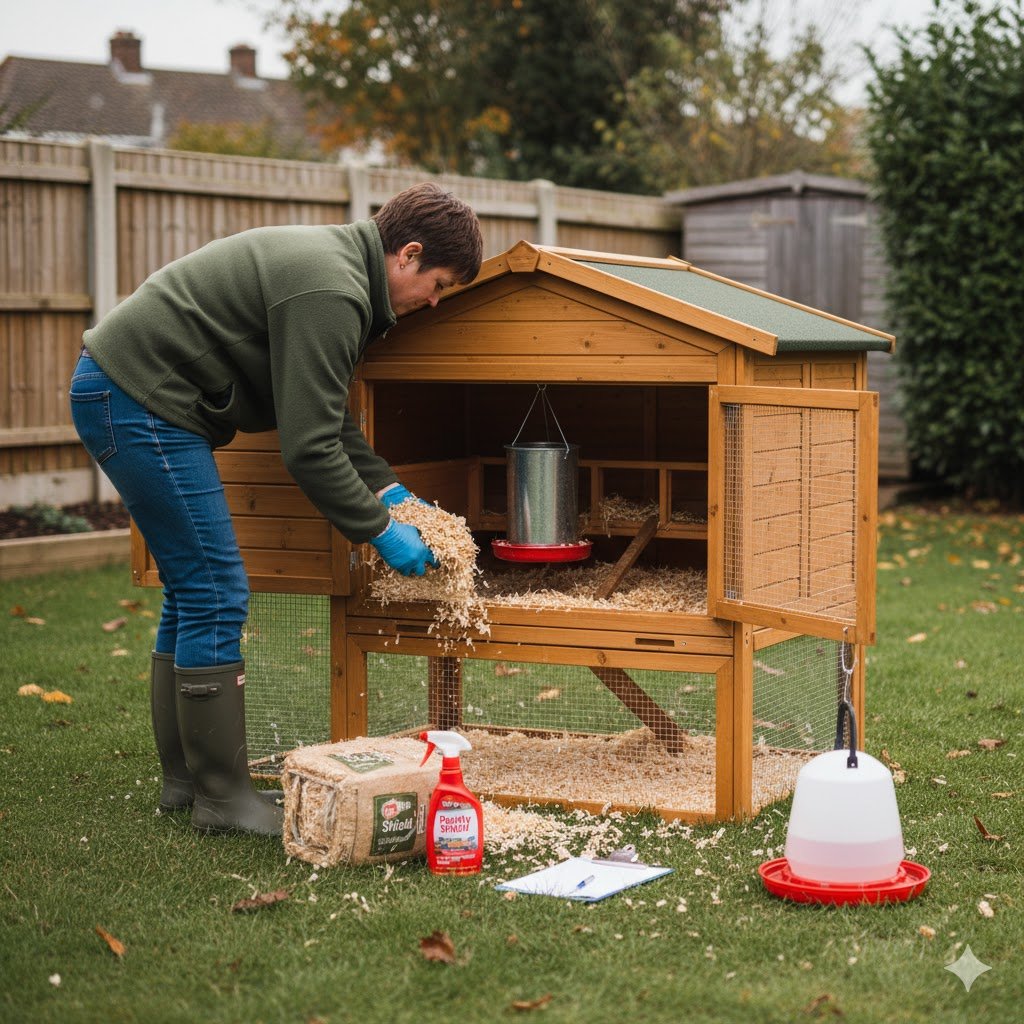
How to prepare for chickens arriving? One week before, complete these final preparation steps.
7 Days Before:
- ✓ Register with APHA on the GOV.UK website.
- ✓ Assemble and position your coop in its final, shaded, sheltered location.
- ✓ Assemble the run and secure it to the coop. Check for any gaps.
- ✓ Test the pop hole door and all locks.
- ✓ Phone local vets and find one that treats poultry. Add their number to your phone.
- ✓ Buy your metal feed bin and your first 20kg bag of feed and store it.
3 Days Before:
- ✓ Deep clean the (even if new) coop with Poultry Shield. Let it air dry completely.
- ✓ Add fresh, deep bedding to the coop floor and nest boxes.
- ✓ Set up your dust bath in a dry, sheltered spot.
- ✓ Test the feeder and drinker for any leaks.
- ✓ Assemble your First Aid Kit in its waterproof box.
1 Day Before:
- ✓ Hang the feeder at the correct height (level with the birds’ backs).
- ✓ Fill the feeder with layer pellets.
- ✓ Fill the drinker with fresh water.
- ✓ Prepare your transport carrier with bedding.
- ✓ Inform your neighbours the chickens are arriving tomorrow!
Arrival Evening (Collection Day):
- ✓ Place the feeder and water INSIDE the coop.
- ✓ Ensure the pop hole door is securely closed.
- ✓ Bring your chickens home in their carrier.
- ✓ Gently place the birds, one by one, inside the coop.
- ✓ Leave them undisturbed to settle for the night.
- ✓ Check on them quietly before you go to bed, just to ensure they’re all settled and on the perches.
Next Morning:
- ✓ Open the pop hole.
- ✓ Move the feeder and drinker out into the run.
- ✓ Don’t force them out. Let them emerge naturally. It may take them hours, and this is normal.
Frequently Asked Questions (FAQs) on UK Chicken Supplies Checklist
Here are some quick answers to the most common questions new UK keepers ask about supplies and preparation.
Do I need a licence to keep chickens in the UK?
No, you do not need a “licence” to keep under 50 birds. However, you must legally register your flock (even one bird) with APHA on the GOV.UK website. It’s free, mandatory, and has been required for all flock sizes since October 1, 2024.
What is the best bedding for chickens in the UK?
For the damp UK climate, a highly absorbent, dust-extracted bedding is best to protect your hens’ respiratory systems. Dust-extracted wood shavings or hemp bedding are the top recommendations. Straw is generally too “stalky” and can get damp and mouldy quickly, so it’s best avoided for the main coop floor (though it’s fine for nest boxes).
How many chickens should I start with?
You should never keep just one chicken, as they are highly social flock animals. A group of 3 or 4 hens is the perfect number to start with. This allows them to establish a pecking order and live happily as a small flock.
Can I really not feed my chickens ANY kitchen scraps?
That’s correct. Under UK law, it is illegal to feed any “catering waste” (any food that has been in your kitchen, even vegan scraps) to chickens. This is to prevent the spread of animal diseases. You can, however, feed them fresh greens or vegetables taken directly from your garden or allotment, as long as they never enter your kitchen.
What’s the real difference between chicken wire and welded mesh?
This is a critical safety point. Chicken wire (the thin, hexagonal wire) is only strong enough to keep chickens in. It will not keep a fox out. Welded mesh (also called hardware cloth) is a thick-gauge wire in a grid pattern. It is the only fencing strong enough to stop a fox, badger, or stoat from tearing or squeezing through it. It is essential for predator-proofing.
How often do I need to clean the coop?
You should do a quick “poo pick” daily, which involves scraping the droppings from the perches and droppings tray (if you have one). This takes 2 minutes. A full “deep clean,” where you change all the bedding, should be done every 1-2 weeks, depending on the number of birds and the size of your coop.
My coop is wooden. How do I stop red mites?
Prevention is key. Red mites are the #1 parasite in the UK. From day one, you must have a plan: 1. Do a regular deep clean with a specific poultry disinfectant like Poultry Shield, which breaks down the mites’ waxy coating. 2. After cleaning and when the coop is dry, puff Diatomaceous Earth (DE) into all the cracks, joints, and perch-ends. This will kill any mites that try to hide.
Conclusion
Bringing chickens home for the first time is incredibly exciting, but as you can see, proper preparation makes all the difference between a smooth start and a stressful scramble. With this complete, in-depth checklist, you are now fully prepared to welcome your new flock.
Your Key Takeaways:
- Register with APHA first: It’s free, simple, and a legal must.
- Have ALL supplies ready and your coop fully built and predator-proofed before collection day.
- Budget for quality: A quality coop and welded mesh are the two most important investments you will make.
- Storage is key: A metal feed bin is non-negotiable.
- Red mite prevention (Poultry Shield, DE) starts from day one.
- Remember the UK law: NO kitchen scraps.
The first few days might feel busy as you all learn the new routine, but within a week, you’ll be settled. And within a month, you’ll wonder how you ever managed without the quiet clucking of garden chickens and the taste of your very first fresh egg.
Print this checklist, tick those items off, and get ready for one of the most rewarding hobbies you’ll ever start.

Oladepo Babatunde is the founder of ChickenStarter.com. He is a backyard chicken keeper and educator who specializes in helping beginners raise healthy flocks, particularly in warm climates. His expertise comes from years of hands-on experience building coops, treating common chicken ailments, and solving flock management issues. His own happy hens are a testament to his methods, laying 25-30 eggs weekly.
